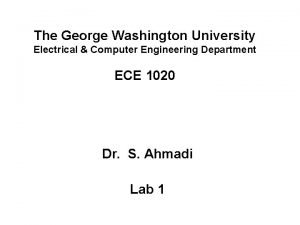Islamic University of Gaza Electrical Engineering Department Electric









- Slides: 9

ﺑﺴﻢ ﺍﻟﻠﻪ ﺍﻟﺮﺣﻤﻦ ﺍﻟﺮﺣﻴﻢ Islamic University of Gaza Electrical Engineering Department

Electric Circuit and Applied Electronics (EMEC 4313) By Basil Hamed, Ph. D. Control Systems Engineering www. iugaza. edu/homes/bhamed http: //site. iugaza. edu. ps/bhamed/

Course Syllabus Islamic University of Gaza Faculty of Engineering Department of Mechanical Engineering Electric Circuit and Applied Electronics (EMEC 4313) Instructor Office e-mail Web. Site : Basil Hamed, Ph. D. Control Systems Engineering : B 336 : bhamed@ iugaza. edu bahamed@hotmail. com : http: //site. iugaza. edu. ps/bhamed/ Phone Meeting : 2860700 Ext. 2875 : (Sun -Tu) 9: 00 -10: 30 (K 208) 3

Course Syllabus • Course Description: An electric circuit is a mathematical model that approximates the behavior of an actual electrical system. Circuit Analysis: An Overview, Voltage, Current and the Basic Circuit Elements. Introduction to electrical networks. Techniques of Circuit Analysis. This course includes semiconductor-based devices such as diodes, bipolar junction transistors (BJTs) 4

Course Syllabus Text Book: Introductory Circuit Analysis, 13 ed. by Robert L. Boylestad Electronic devices and circuit theory by Robert L. Boylestad & Louis Nashelsky Teaching Assistant Eng. 5

Course Syllabus Course Aim: • To introduce class participants to the basic concepts of circuit variable, basic circuit elements, and basic electronics devices. • analysis as a fundamental tool in engineering. • To introduce class participants to basic circuit analysis, design, and measurement of linear analog electrical & electronics systems important across engineering disciplines. • Understand, & apply, the concept of operation of diodes, zener diodes, LEDs, BJTs. • To provide the students an opportunity to apply the knowledge of above material in a practical (Lab) experience 6

Course Syllabus Materials Covered: 1. Circuit Variables and Circuit Elements. 2. Ohm’s Law, Power, and Energy 3. Series, and Parallel dc circuits, Kirchhoff’s voltage law, Kirchhoff’s current law 4. Techniques of Circuit Analysis; Mesh Current, Node Voltage, Superposition Theorem, Thevenin & Norton Theorems, Maximum Power transfer 5. Explain the physical basis of operation of a p-n junction diode and be able to use this understanding to calculate its behavior as a circuit element 6. Explain the physical basis of operation of Bipolar Junction 7 Transistors (BJT)

Course Syllabus Grading System: Homework &Quizzes Mid term Exam 4/11/2019 Final Exam 12/1/2020 1: 00 -2: 00 11: 00 - 1: 00 20 % 30 % 50 % Quizzes: Will be given in the discussion by the T. A Homework assignments are to be returned on time. No excuses will be accepted for any delay. Office Hours Open-door policy, by appointment or as posted. 8

See You next Tuesday 9
 Electrical engineering department
Electrical engineering department Tum department of electrical and computer engineering
Tum department of electrical and computer engineering Ucla systems engineering
Ucla systems engineering Tel aviv university electrical engineering
Tel aviv university electrical engineering University of belgrade school of electrical engineering
University of belgrade school of electrical engineering Gwu electrical engineering
Gwu electrical engineering Clemson university electrical engineering
Clemson university electrical engineering Tel aviv university electrical engineering
Tel aviv university electrical engineering George washington university electrical engineering
George washington university electrical engineering Sınıfı
Sınıfı

















